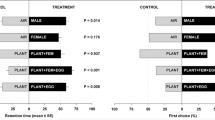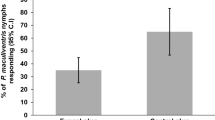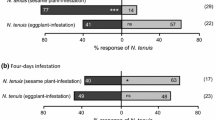Abstract
Studies of multitrophic interactions show that insect faeces may act as a defensive device against predators, as kairomone source for attraction of antagonists and as a significant energy source for micro-organisms. In the present study, we investigated effects of larval faeces from leaf beetles of the subfamiliy Cassidinae towards a generalist predator, the ant Myrmica rubra. Most cassidine larvae collect their faeces together with exuviae as so-called abdominal defensive shields on two movable spines at the posterior tip. The effects of these abdominal shields towards M. rubra were studied in three cassidine species, which feed mono- or oligophagously upon tansy (Chrysanthemum vulgare): Cassida denticollis and C. sanguinosa which possess such faecal shields and, for comparison, C. stigmatica with shields made of exuviae only (=skin shield). Bioassays revealed that larvae with both faecal and skin shields were attacked by the ant M. rubra more often than larvae whose shields had been removed. This attractiveness of shields towards ants contrasts with other studies, which found that abdominal shields of chrysomelid larvae act as defensive mechanisms against generalist predators like ants. To characterize the attractive cues of the shields, we studied possible chemical and physical stimuli. Olfactometer bioassays with M. rubra and chemical analyses revealed that plant-derived volatiles from faecal shields of C. denticollis attracted the ant, whereas odour from skin shields of C. stigmatica did not. Skin shields also emitted volatiles which derived from tansy, but in much lower quantities. Exclusion of contact to surface chemicals of a faecal shield reduced the ants' aggressive behaviour, whereas a change in the moisture content of a faecal shield had no influence. Visual stimuli cannot be ruled out as enhancing the ants' reaction towards faecal shields with their attractive volatiles, and are suggested to play a major role in the ants' response towards skin shields. This novel attractive effect of the abdominal shields of cassidine larvae is discussed, especially with respect to host plant chemistry and possible functions of the shields that might outweigh the negative consequences of the attraction of the predator M. rubra.
Similar content being viewed by others
Author information
Authors and Affiliations
Additional information
Received: 22 June 1998 / Accepted: 2 November 1998
Rights and permissions
About this article
Cite this article
Müller, C., Hilker, M. Unexpected reactions of a generalist predator towards defensive devices of cassidine larvae (Coleoptera, Chrysomelidae). Oecologia 118, 166–172 (1999). https://doi.org/10.1007/s004420050715
Issue Date:
DOI: https://doi.org/10.1007/s004420050715




